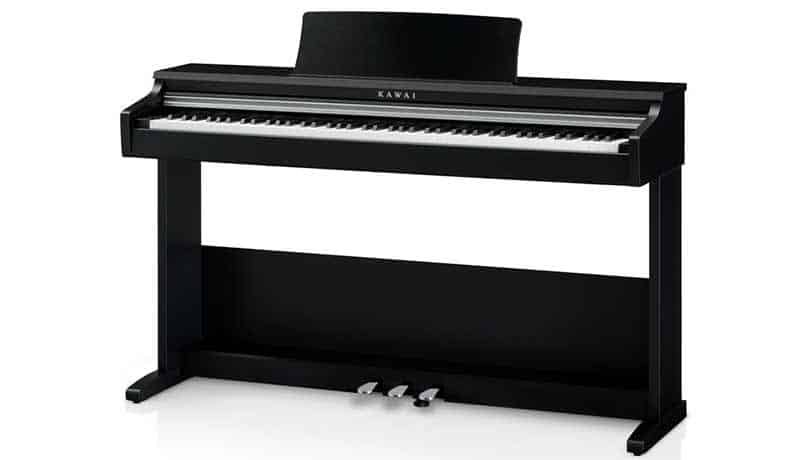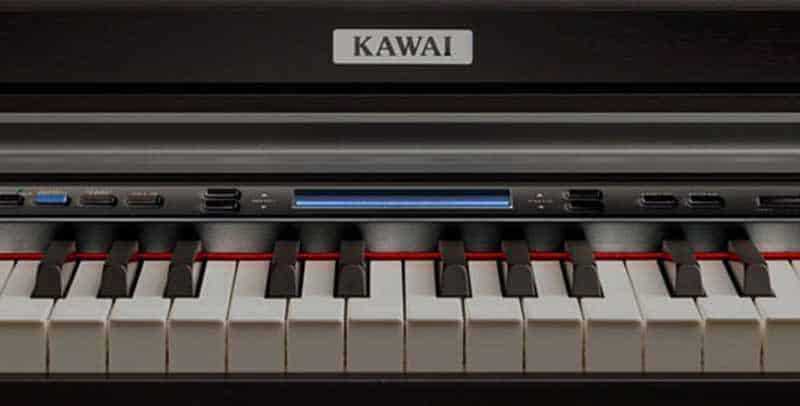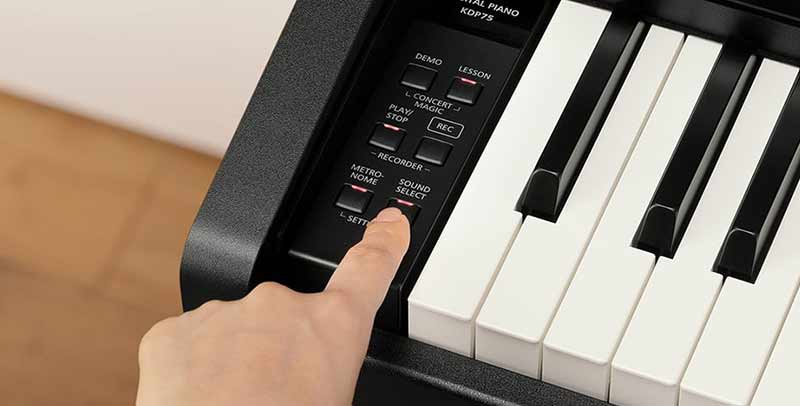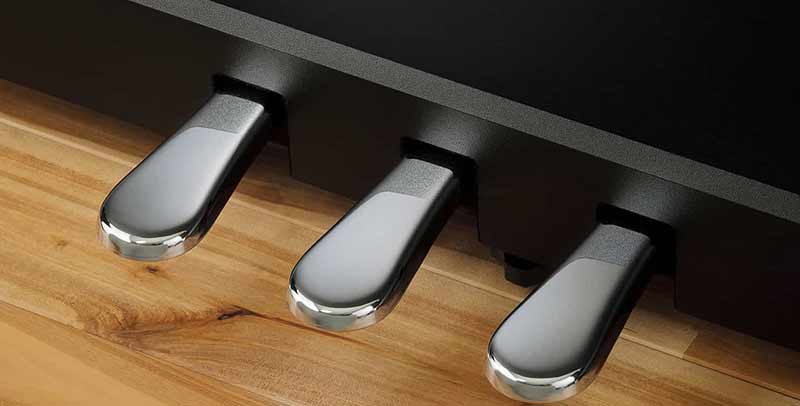Introduction

When it comes to affordable home-based digital pianos, few companies can compete with Kawai. Today, we’re going to be looking at the Kawai KDP70 digital piano.
We have already done a comparison between the KDP70 and the upgraded KDP110, but this is a very deserving and interesting high-value digital piano that we wanted to take a longer peek at.
We’ll be discussing the piano sound, touch, and important features of this KDP series model. We hope you enjoy this article and would encourage you to check out the companion video review, so you can hear this thing in action.
Opening Thoughts
As mentioned above, the KDP70 is the little sibling of the KDP110. With that, there are some similarities between the spec-sheets of these two, and of course, some differences that attempt to justify the price premium the KDP110 commands.
The biggest similarities between the two pianos are definitely their control interfaces, as they’re exactly the same. The sound engines are fairly similar as well, so let’s start there.
Piano Sound
The Kawai KDP70 has 192 notes of polyphony, which is actually the same amount that the KDP110 has. This means you’ll have plenty of bandwidth to be able to play this instrument with a single layer of sound or even with two layers of sound without any fear that the tone generator will start dropping notes.
If you’d like to learn more about Polyphony, we have a video all about it on our YouTube channel.
When it comes to the wattage and the speaker system on the KDP70, we have one of the largest amplifiers of any instrument in the class with a 16-watt stereo amplifier in the KDP70. This is a surprising amount of power when you’re playing it at about three-quarters volume, which is a good place to set your volume when playing a digital piano.
There’s a surprising amount of attack and really strong treble here courtesy of the speakers and tone engine, which in this case, is Kawai’s Harmonic Imaging sound engine with a full 88-key sampling of the expressive Kawai EX concert grand piano.

One of the things that digital piano technology has been challenged to try and reproduce over the years is actually the imperfections that you get on an acoustic piano rather than the perfections.
Since the Harmonic Imaging engine is simply a stereo recording of each of the 88 notes of a real piano, you can hear the very subtle differences between those notes. Those imperfections, when you combine them together, really do make a difference in creating the illusion of an additional layer of realism.

Most of the other options available in the price range that the KDP70 occupies will be the instruments with a mono sample rather than a stereo sample of each note, or where only one in four notes is recorded, and the sample is stretched to fill in the non-recorded notes.
There are 15 sounds in total here, including 3 acoustic pianos in addition to the main concert grand piano sound, 2 electric pianos, 2 organs, and then things like strings, vibraphone, harpsichord, and synthesizer.
In addition to the sounds, you also have the ability to make some adjustments to the reverb. There’s even damper resonance, which is pretty crazy for the price range.
Once everything gets factored in, the KDP70 makes a strong argument for offering the best all-around piano sound in its price class. Let’s move on to the action.

Piano Action
Another piano the KDP70 has a lot in common with is the Kawai ES110. One would think that the KDP110 and the ES110 would have more parallels because of how they’ve named them. In fact, the KDP70 actually has more in common with the ES110 than the KDP110 does.
One of those commonalities is the action.
The action is Kawai’s authentic Responsive Hammer Compact keyboard action (RHC), which is a first-generation version of this action, and uses a dual sensor. The upgraded second-generation version of this action, which is featured in the KDP110, has a triple sensor, meaning the KDP70’s action will be less accurate from a dynamic output perspective.

For most people who are shopping at this price point, a dual-sensor versus triple sensor is realistically not going to make a huge impact on the playing experience. But for getting into some serious classical rep, or looking to do some MIDI triggering, this might be a big deal.
In any case, let’s take a closer look at this version of the RHC – what are we getting? What we do get is a very nice key surface on both the white and the black keys for a good sense of grip.
It does not have any escapement/let-off. If you’re thinking about buying a practice instrument with a good carry-over to an acoustic grand piano, you may want to spend the extra money on the action with escapement to better approximate the feel of an acoustic piano, as the transition between instruments will be easier.

Another positive thing about this action, and this is true of Kawai’s actions in general, is that the key bed is very well-cushioned. As a result, this is one of the quieter actions out there, which can actually be a big deal to some people.
The repetition speed is quite decent, though the black keys move laterally a little more than is ideal when you start pushing the action. This isn’t the case with Kawai’s more expensive actions.
For the audience that this piano is intended for, this is one of the best actions available out there. We would still put Roland’s PHA4 action ahead, and of course the newer RHCII, but overall, for the price, this is a very solid action. Onto features and connectivity.
Piano Features & Connectivity
The Kawai KDP70 comes with an integrated stand, a triple pedal system with half-pedal support, and a matching bench, and is available in an Embossed Black finish that really compliments the cabinet design.

It’s not designed to look like a black wood finish, but almost a black egg shell-like finish – super slick.
In terms of connectivity, the KDP70 is definitely missing some functionality. It does have traditional 5-pin MIDI out ports and dual headphone jacks, but there are unfortunately no USB ports, output jacks, or Bluetooth.
You can still connect to devices for apps and computers via the 5-pin MIDI, but you will need to invest in an adapter.
The Kawai KDP70 has some popular lesson songbooks built-in, such as Alfred, Burgmuller, and Czerny, along with a lesson function.
There are of course also staple features like a metronome, dual-mode, four-hands mode, and Concert Magic, which can actually help beginners develop their sense of rhythm.

Closing Thoughts
For the price, the KDP70 offers beginners, students, and even more advanced players looking for a solid practice instrument an affordable entry point to the world of Kawai pianos.
The sound engine is probably the biggest highlight along with the 16-watt speakers, but the action is solid, as is the cabinet. It’s also a nice bonus that Kawai ships it with a stand and free matching bench.
Yamaha does this too with their comparable models, but Casio interestingly does not.
If you’re in the Toronto area, pop into one of our showrooms to try the KDP70 out for yourself, and definitely check out our video review of the KDP70!

